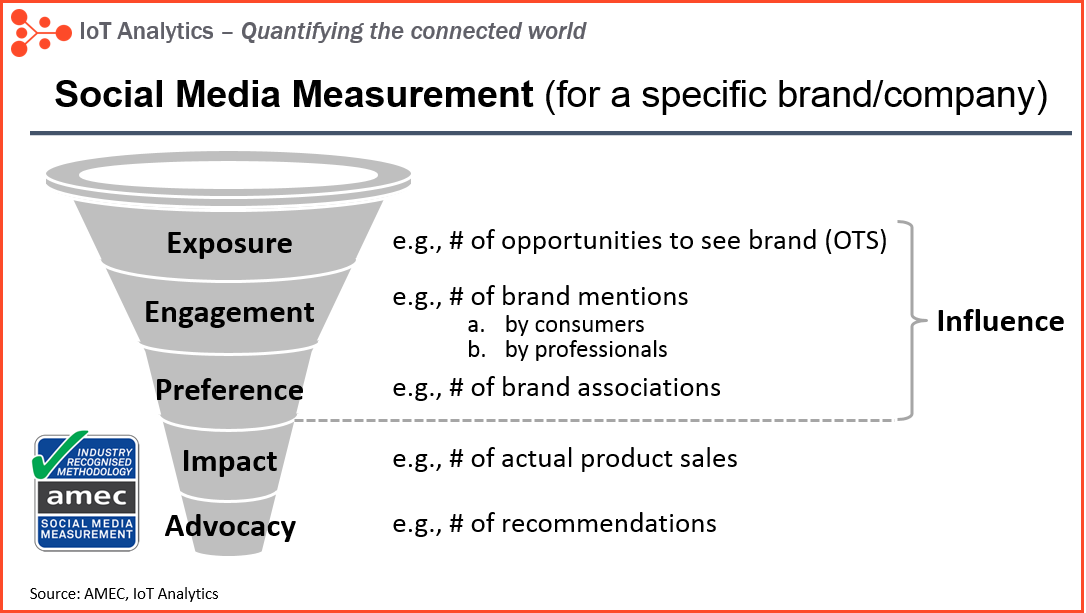“Internet of Things” influencers ranking – Summary
- Google is the biggest IoT influencer in November 2014, followed by IBM and Apple.
- Arduino is the most efficient IoT influencer in November 2014, followed by IDC and ARM.
- US companies dominate the IoT influencers ranking
- While Google leads in IoT exposure and professional engagement, Cisco gets the most people actively looking for them (preference).
- Arduino leads the consumer engagement category in absolute terms. However, professionals aren’t engaging and the press is not covering them either.
Ranking
Absolute company ranking
Which companies have the highest influence(1) on IoT stakeholders(2)?
- Highest influence is determined by the levels of exposure, engagement, and preference on the web, in the press, and on social media
- IoT stakeholders includes all people being exposed to the Internet of Things (especially: thought leaders, employees, potential customers, professionals, general consumers)
| Absolute rank | Company | Category | Country | Total score | Exposure | Consumer engagement | Professional engagement | Preference |
| Devices + Software | 11 | 1 | 4 | 1 | 5 | |||
| IBM | Software | 14 | 4 | 2 | 5 | 3 | ||
| Apple | Devices | 17 | 2 | 3 | 2 | 10 | ||
| Microsoft | Software | 19 | 3 | 8 | 4 | 4 | ||
| Cisco | Networking equipment | 24 | 12 | 6 | 5 | 1 | ||
| Intel | Semi-conductor | 32 | 10 | 7 | 13 | 2 | ||
| Gartner | Market research | 33 | 11 | 10 | 7 | 5 | ||
| SAP | Software | 35 | 8 | 5 | 11 | 11 | ||
| Samsung | Devices | 36 | 6 | 11 | 8 | 11 | ||
| Oracle | Software | 42 | 9 | 13 | 12 | 8 |

Relative company ranking
Which companies are the most efficient(1) in influencing IoT stakeholders(2)?
- Most efficient is determined by the levels of exposure, engagement, and preference on the web, in the press, and on social media. It is normalized for every company by the number of total employees in the company.
- IoT stakeholders includes all people being exposed to the Internet of Things (especially: thought leaders, employees, potential customers, professionals, general consumers)
| Relative rank | Company | Category | Country | Total score | Exposure | Consumer engagement | Professional engagement | Preference |
| Arduino | Builder boards | 5 | 2 | 1 | 1 | 1 | ||
| IDC | Market research | 12 | 1 | 3 | 5 | 3 | ||
| ARM | Semi-conductors | 14 | 4 | 2 | 3 | 5 | ||
| Gartner | Market research | 15 | 3 | 4 | 4 | 4 | ||
| Devices + Software | 23 | 5 | 5 | 2 | 11 | |||
| Cisco | Network equipment | 34 | 10 | 7 | 11 | 6 | ||
| Apple | Devices | 39 | 6 | 8 | 7 | 18 | ||
| SAP | Software | 42 | 7 | 6 | 12 | 17 | ||
| Microsoft | Software | 43 | 8 | 11 | 9 | 15 | ||
| Intel | Semi-conductors | 43 | 11 | 9 | 14 | 9 |
Motivation for the IoT influencers ranking
The Internet of Things is the next big thing. For some firms this is obvious. Cisco, GE, or IBM are shifting their corporate strategies to become IoT companies. Cisco now has at least 657* people working in IoT followed by Intel with 487 and Microsoft with 454.
Like a gold rush?
Some people are comparing the sentiment in these companies to the gold rush in California in 1849. After gold was discovered by James Marshall in 1848, thousands of immigrants started pouring into California from all over the world. Everybody wanted to claim the most attractive pieces of soil before someone else had.
Claiming these spots in 2014 terminology means betting on the right IoT business models and putting the company name in the mind of the customer.
You can have hundreds of people looking for gold and hit nothing but rocks… if you look in the wrong spot. The best gold diggers were either lucky or they found smart ways to analyze soil samples. Same thing for the IoT gold rush: The likelihood of success can be measured for companies active in a new field like IoT.
Getting into the mind of the customer
Getting into the mind of the customer means exposing yourself and getting people, experts, and other stakeholders talking and looking for you. Google, Twitter, LinkedIn and other websites facilitate and enable this measurement. It enables companies to quickly adapt their strategies based on what resonates with these stakeholders and what doesn’t.
How successful are individual companies at getting into the minds of customers and experts? Whose products, ideas, and topics get people talking? If it can be measured, it can be ranked. To get an objective indicator, we created the IoT Influencers ranking. The Goal: Measure which companies succeed in shaping the minds of stakeholders in IoT. And which companies are most efficient in doing so.
Methodology for the IoT influencers ranking
The framework
The IoT Influencers ranking makes use of the Social Media Valid Framework. It was developed by AMEC, the international association for the measurement and evaluation of communication, to measure social media. The framework has been adapted from the traditional purchase funnel to determine the communication patterns of the social media world. (http://amecorg.com/social-media-measurement/ )

Scoring the companies
The IoT influencers ranking focusses on the first three steps in the Social Media Measurement framework: Exposure, engagement, and preference.
Exposure
Exposure describes the potential audience that is exposed to content or specific messages. It is measured in OTS (opportunities to see).The IoT influencers ranking measures the appearance of the company name in conjunction with IoT in press/news articles. This is used as a proxy for OTS.
Engagement
Engagement describes the interaction that occurs in response to exposed content. It is measured in brand mentions. The IoT influencers ranking distinguishes consumer engagement and professional engagement.
- Consumer engagement: The ranking measures Twitter hashtag usage of the brand in conjunction with IoT.
- Professional engagement: The ranking measures brand name usage in LinkedIn discussions in conjunction with IoT.
Preference
Preference describes the ability to cause or contribute a change in opinion or behavior (of the engaged audience). It is measured in “brand association with a topic”. The IoT influencers ranking measures the number of active web searches for a company in conjunction with IoT. This is used as a proxy for preference.
Ranking the companies
Prerequisites to appear in the IoT influencers ranking
Companies must:
- be tracked in the IoT Analytics database of IoT companies
- be at least 10 relevant Google searches per month for the company in conjunction with IoT.
Determining the ranking
Each of the four measurement categories are ranked individually: Exposure, Consumer engagement, professional engagement, and preference. Then, an average score is being determined, weighing each of the categories equally. This score is used to determine a final ranking for the IoT influencers.
Absolute vs. relative ranking
The absolute ranking measures which company has the highest overall influence on stakeholders in IoT. Small companies have limited resources and generally a lower brand awareness. These companies will find it a lot harder to influence a large amount of people. Therefore, a second, relative ranking has been established.
The relative ranking measures which company is the most efficient overall influencer on stakeholders in IoT. To determine this ranking, each measure is normalized by the total number of employees in the company.
Feedback
If you have any questions, ideas how to improve the IoT influencers ranking or further feedback, please contact us info@iot-analytics.com
*Number of LinkedIn profiles with current employer as Cisco and the tag “internet of things” in the profile

